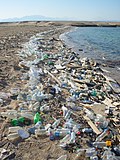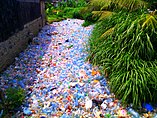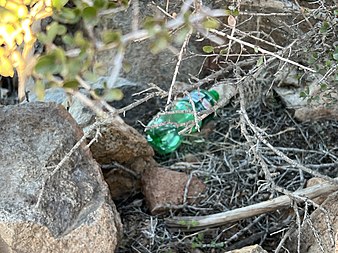
Back تلوث لدائني Arabic Plastik çirklənmə Azerbaijani Polusyon sa plastik BCL प्लास्टिक प्रदूषण Bihari প্লাস্টিক দূষণ Bengali/Bangla Contaminació per plàstics Catalan Znečištění plasty Czech Llygredd plastig Welsh Plastforurening Danish Plastic pollution DAG
- Olive ridley sea turtle entangled in a ghost net in the Maldives
- Plastic pollution of Sharm el-Naga beach, near Safaga, Egypt
- Piles of plastic waste on the government-authorized "garbage island" of Thilafushi, Maldives
- Canada Dry plastic bottle on hiking trail in the United States adjacent to an urban hiking trail.
- A tributary of the Wouri River in Douala, Cameroon, completely clogged with plastic.
| Part of a series on |
| Pollution |
|---|
 |
Plastic pollution is the accumulation of plastic objects and particles (e.g. plastic bottles, bags and microbeads) in the Earth's environment that adversely affects humans, wildlife and their habitat.[1][2] Plastics that act as pollutants are categorized by size into micro-, meso-, or macro debris.[3] Plastics are inexpensive and durable, making them very adaptable for different uses; as a result, manufacturers choose to use plastic over other materials.[4] However, the chemical structure of most plastics renders them resistant to many natural processes of degradation and as a result they are slow to degrade.[5] Together, these two factors allow large volumes of plastic to enter the environment as mismanaged waste which persists in the ecosystem and travels throughout food webs.[6][7]
Plastic pollution can afflict land, waterways and oceans. It is estimated that 1.1 to 8.8 million tonnes of plastic waste enters the ocean from coastal communities each year.[8] It is estimated that there is a stock of 86 million tons of plastic marine debris in the worldwide ocean as of the end of 2013, with an assumption that 1.4% of global plastics produced from 1950 to 2013 has entered the ocean and has accumulated there.
[9] Global plastic production has surged from 1.5 million tons in the 1950s to 335 million tons in 2016, resulting in environmental concerns. A significant issue arises from the inefficient treatment of 79% of plastic products, leading to their release into landfills or natural environments. [10]
Some researchers suggest that by 2050 there could be more plastic than fish in the oceans by weight.[11] Living organisms, particularly marine animals, can be harmed either by mechanical effects such as entanglement in plastic objects, problems related to ingestion of plastic waste, or through exposure to chemicals within plastics that interfere with their physiology. Degraded plastic waste can directly affect humans through direct consumption (i.e. in tap water), indirect consumption (by eating plants and animals), and disruption of various hormonal mechanisms.[12]
As of 2019, 368 million tonnes of plastic is produced each year; 51% in Asia, where China is the world's largest producer.[13] From the 1950s up to 2018, an estimated 6.3 billion tonnes of plastic has been produced worldwide, of which an estimated 9% has been recycled and another 12% has been incinerated.[14] This large amount of plastic waste enters the environment and causes problems throughout the ecosystem; for example, studies suggest that the bodies of 90% of seabirds contain plastic debris.[15][16] In some areas there have been significant efforts to reduce the prominence of free range plastic pollution, through reducing plastic consumption, litter cleanup, and promoting plastic recycling.[17][18]
As of 2020, the global mass of produced plastic exceeds the biomass of all land and marine animals combined.[19] A May 2019 amendment to the Basel Convention regulates the exportation/importation of plastic waste, largely intended to prevent the shipping of plastic waste from developed countries to developing countries. Nearly all countries have joined this agreement.[20][21][22][23] On 2 March 2022 in Nairobi, 175 countries pledged to create a legally binding agreement by the end of the year 2024 with a goal to end plastic pollution.[24]
The amount of plastic waste produced increased during the COVID-19 pandemic due to increased demand for protective equipment and packaging materials.[25] Higher amounts of plastic ended up in the ocean, especially plastic from medical waste and masks.[26][27] Several news reports point to a plastic industry trying to take advantage of the health concerns and desire for disposable masks and packaging to increase production of single use plastic.[28][29][30][31]
- ^ "Plastic pollution". Encyclopædia Britannica. Retrieved 1 August 2013.
- ^ Laura Parker (June 2018). "We Depend on Plastic. Now We're Drowning in It". NationalGeographic.com. Archived from the original on 16 May 2018. Retrieved 25 June 2018.
- ^ Hammer, J; Kraak, MH; Parsons, JR (2012). "Plastics in the Marine Environment: The Dark Side of a Modern Gift". Reviews of Environmental Contamination and Toxicology. Vol. 220. pp. 1–44. doi:10.1007/978-1-4614-3414-6_1. ISBN 978-1461434139. PMID 22610295. S2CID 5842747.
- ^ Hester, Ronald E.; Harrison, R. M. (editors) (2011). Marine Pollution and Human Health. Royal Society of Chemistry. pp. 84–85. ISBN 184973240X
- ^ Le Guern, Claire (March 2018). "When The Mermaids Cry: The Great Plastic Tide". Coastal Care.
- ^ Cite error: The named reference
Wormwas invoked but never defined (see the help page). - ^ Cite error: The named reference
Ongwas invoked but never defined (see the help page). - ^ Jambeck, Jenna R.; Geyer, Roland; Wilcox, Chris; Siegler, Theodore R.; Perryman, Miriam; Andrady, Anthony; Narayan, Ramani; Law, Kara Lavender (13 February 2015). "Plastic waste inputs from land into the ocean". Science. 347 (6223): 768–771. Bibcode:2015Sci...347..768J. doi:10.1126/science.1260352. PMID 25678662. S2CID 206562155.
- ^ Jang, Y. C., Lee, J., Hong, S., Choi, H. W., Shim, W. J., & Hong, S. Y. 2015. "Estimating the global inflow and stock of plastic marine debris using material flow analysis: a preliminary approach". Journal of the Korean Society for Marine Environment and Energy, 18(4), 263–273.[1]
- ^ Li, Penghui; Wang, Xiaodan; Su, Min; Zou, Xiaoyan; Duan, Linlin; Zhang, Hongwu (1 October 2021). "Characteristics of Plastic Pollution in the Environment: A Review". Bulletin of Environmental Contamination and Toxicology. 107 (4): 577–584. Bibcode:2021BuECT.107..577L. doi:10.1007/s00128-020-02820-1. ISSN 1432-0800. PMID 32166334. S2CID 212681362.
- ^ Sutter, John D. (12 December 2016). "How to stop the sixth mass extinction". CNN. Retrieved 18 September 2017.
- ^ Ziani, K; Ioniță-Mîndrican, CB; Mititelu, M; Neacșu, SM; Negrei, C; Moroșan, E; Drăgănescu, D; Preda, OT (25 January 2023). "Microplastics: A Real Global Threat for Environment and Food Safety: A State of the Art Review". Nutrients. 15 (3): 617. doi:10.3390/nu15030617. PMC 9920460. PMID 36771324.
- ^ "Plastics – the Facts 2020" (PDF). Archived from the original (PDF) on 1 September 2021. Retrieved 6 October 2021.
- ^ "The known unknowns of plastic pollution". The Economist. 3 March 2018. Retrieved 17 June 2018.
- ^ Nomadic, Global (29 February 2016). "Turning rubbish into money – environmental innovation leads the way".
- ^ Cite error: The named reference
plasticizerwas invoked but never defined (see the help page). - ^ Walker, Tony R.; Xanthos, Dirk (2018). "A call for Canada to move toward zero plastic waste by reducing and recycling single-use plastics". Resources, Conservation and Recycling. 133: 99–100. doi:10.1016/j.resconrec.2018.02.014. S2CID 117378637.
- ^ "Picking up litter: Pointless exercise or powerful tool in the battle to beat plastic pollution?". unenvironment.org. 18 May 2018. Retrieved 19 July 2019.
- ^ Laville, Sandra (9 December 2020). "Human-made materials now outweigh Earth's entire biomass – study". The Guardian. Retrieved 9 December 2020.
- ^ National Geographic, 30 Oct. 2020, "U.S. Generates More Plastic Trash than Any Other Nation, Report Finds: The Plastic Pollution Crisis Has Been Widely Blamed on a Handful of Asian Countries, But New Research Shows Just How Much the U.S. Contributes"
- ^ UN Environment Programme, 12 May 2019 "Governments Agree Landmark Decisions to Protect People and Planet from Hazardous Chemicals and Waste, Including Plastic Waste"
- ^ The Guardian, 10 May 2019, "Nearly All Countries Agree to Stem Flow of Plastic Waste into Poor Nations: US Reportedly Opposed Deal, which Follows Concerns that Villages in Indonesia, Thailand and Malaysia Had ‘Turned into Dumpsites’"
- ^ Phys.org, 10 May 2019 "180 Nations Agree UN Deal to Regulate Export of Plastic Waste"
- ^ "Historic day in the campaign to beat plastic pollution: Nations commit to develop a legally binding agreement". UN Environment Programme (UNEP). 2 March 2022. Retrieved 11 March 2022.
- ^ Shams, Mehnaz; Alam, Iftaykhairul; Mahbub, Md Shahriar (October 2021). "Plastic pollution during COVID-19: Plastic waste directives and its long-term impact on the environment". Environmental Advances. 5: 100119. Bibcode:2021EnvAd...500119S. doi:10.1016/j.envadv.2021.100119. ISSN 2666-7657. PMC 8464355. PMID 34604829.
- ^ Ana, Silva (2021). "Increased Plastic Pollution Due to Covid-19 Pandemic: Challenges and Recommendations". Chemical Engineering Journal. 405: 126683. Bibcode:2021ChEnJ.40526683P. doi:10.1016/j.cej.2020.126683. PMC 7430241. PMID 32834764.
- ^ Cite error: The named reference
Euronews Bubble Barrierwas invoked but never defined (see the help page). - ^ "Plastics industry adapts to business during COVID-19". Plastics News. 13 March 2020. Retrieved 18 December 2021.
- ^ "Plastic in the time of a pandemic: protector or polluter?". World Economic Forum. 6 May 2020. Retrieved 18 December 2021.
- ^ Monella, Lillo Montalto (12 May 2020). "Will plastic pollution get worse after the COVID-19 pandemic?". euronews. Retrieved 18 December 2021.
- ^ Westervelt, Amy (14 January 2020). "Big Oil Bets Big on Plastic". Drilled News. Archived from the original on 18 December 2021. Retrieved 18 December 2021.
© MMXXIII Rich X Search. We shall prevail. All rights reserved. Rich X Search




